Dark Blue Non Metallic Base Clear Coat Auto
So far, in our Painting 101 Series, we've covered how to turn your home garage into a paint booth, which paint to use, choosing primers and sealers, and proper use of body fillers. Now, JoAnn Bortles talks about choosing what kind of paints you need for your hot rod. -Ed
When choosing the final color for your project, it's critical to understand the different kinds of basecoats, as well as how basecoat paints work. For example, pearl basecoat is very different from candy basecoat, and what exactly is a single-stage? Once you know and understand the different types of basecoat paint, you can make an informed decision on the best paint for your project, as well as what paint will work with your skill level.
There are two kinds of basecoat paint systems. One is a two-part basecoat, which consists of a basecoat, topcoated with urethane clear. The other is a single-stage basecoat, which contains a hardener and acts like a urethane topcoat. But which system should you use for your project?
Single-Stage Basecoats
Single-stage paints are an all-in-one paint designed to achieve several things at once. They are color coats that give full coverage, produce gloss, and offer durability. Everything happens in one application. Single-stage paints are handy to use for traditional restorations when you're spraying a solid, non-metallic color. But, single-stage paints don't have much depth, because it's sprayed in medium to heavy coats. It's not a good choice for metallic colors, as spraying metallics too heavily can cause streaking, mottling, or an uneven effect.
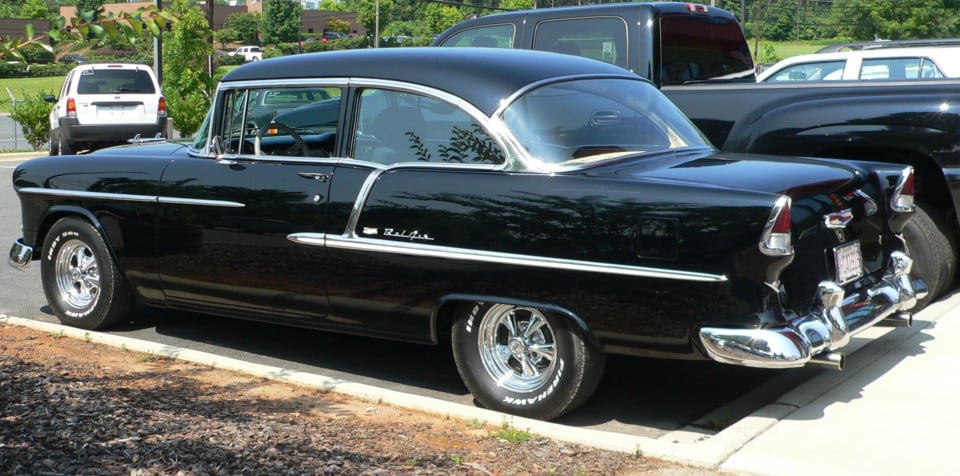
If you're looking for the deepest, darkness black you can get for your project ride, then black single-stage paint might be the answer.
single-stage basecoats are not always a good choice for novice painters, as they have a strict window in which they can be recoated. This leaves little freedom and no room for mistakes. This type of paint is used on single-color paintjobs, where no artwork will be done. If you're doing any taping or artwork over your basecoat, the single-stage must be thoroughly cured, or the tape might leave impressions in it. Once the sprayed paint has sat overnight, single-stage must also be sanded before more paint can be applied.
One advantage of single-stage paint is that it is pure color. While a black truck that has been clearcoated will appear as a very dark black, the clearcoat will slightly mute the pure darkness of the black. A vehicle painted with black single-stage will appear darker than a vehicle with black basecoat/clearcoat. Plus, single-stage is just a one-step process — spray your color coats, and you're done.
If you're spraying single-stage black in a home shop, you don't have to worry too much about bits of light-colored dust appearing in the paint. The black paint will cover up any light bits that land in the finish. Conversely, those light bits will show through any clear urethane sprayed over your black basecoat, when spraying a basecoat/clearcoat.
Single-stage has lower solids than urethane clearcoat, so it's softer than a basecoat/urethane-clear finish. It will still get swirls and scratches like urethane clearcoat, but it will also oxidize faster. So, care must be taken to buff and polish so your single-stage finish will continue to look brand new.
Also, single-stage colors are designed to be applied over properly cleaned and sanded 2K primers or 2K sealers. They are sprayed in wet coats similar to a clearcoat application.
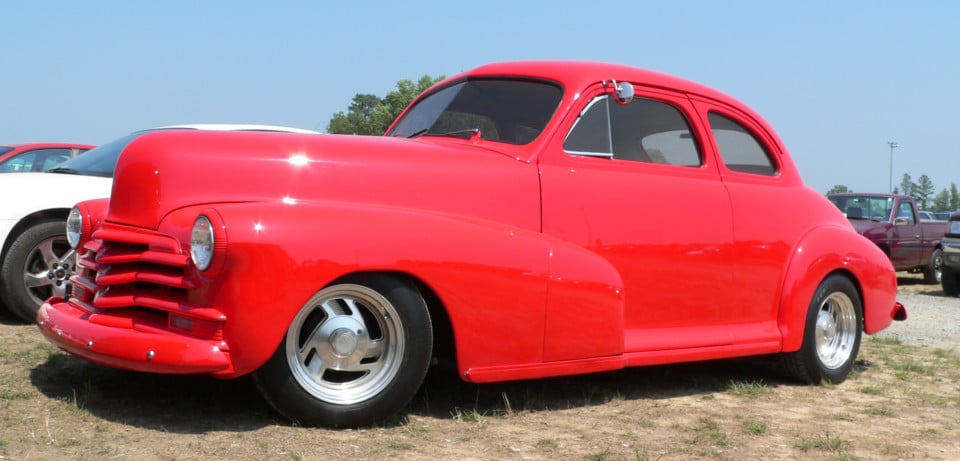
You don't have to spray a metallic or candy-color basecoat to get an incredible paint job. This solid red has no metallic in it and its amazing. Solid colors are an excellent choice for beginning painters.
Two-Stage Basecoat/Clearcoat Systems
Two-stage basecoat is a type of paint that is applied in two steps. The first step is applying the basecoat (color coat), after the primer or sealer. Then, the urethane clearcoat is applied after the basecoat is ready for topcoating. It's very easy to use and is a great system for beginning painters, as it gives the novice the option of stopping between steps. It allows for the freedom to correct mistakes and start over if needed. While two-stage paints cost more and take longer to apply, it tends to offer a longer-lasting finish.
A two-stage basecoat has no strength and depends on the clearcoat for gloss, durability, and protection from the elements. The window between coats is very forgiving, as the reducer used in the basecoat has the ability to soften the previous layer to obtain a chemical bond. This means better adhesion between coats and less chance for delamination problems over time.
Basecoats cover better and faster than single-stage but have a low-gloss characteristic. They are also low in solids, which means the thickness of the paint coat is 1/3 less than single-stage or urethane clearcoat. Because of this, they work great for doing artwork and most kinds of custom paint. The painted edge is thinner and levels out quicker when clearcoated. Custom paint tends to require more coats of paint than single-color paintjobs, so this system is great for doing candy and pearl paints.
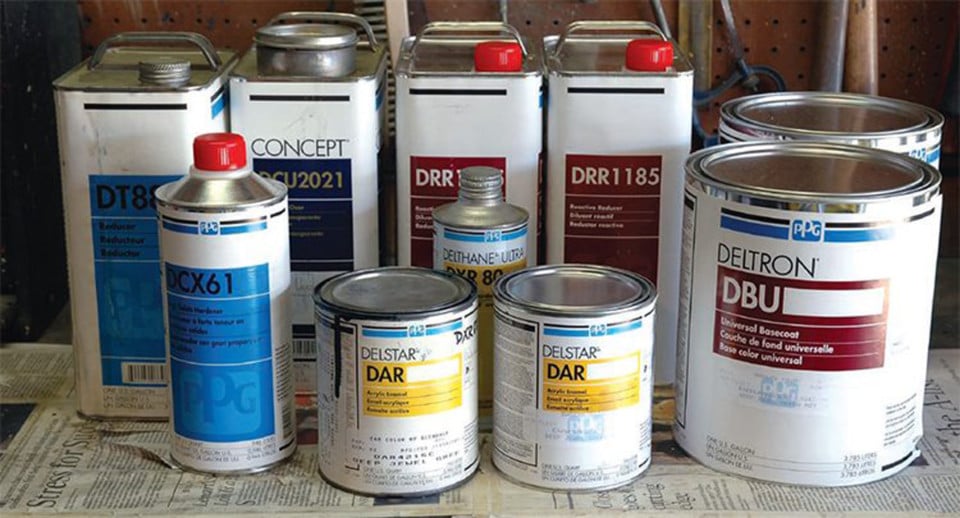
This represents just the color and clearcoat, with reducers and catalysts to paint on one car. It doesn't include any primers, sealers, cleaners, or other "prep" products.
The basecoat of a two-stage system is applied in medium coats. Remember, the more coats applied, the longer it will take to dry between coats. Pay careful attention to recommended recoat windows. If the basecoat is clearcoated without allowing the solvents to properly gas out, those solvents will have to "fight" their way through the clearcoat. That smooth glossy surface you saw right after the clearcoat was sprayed will acquire a slight dullness to it. This is called dieback.
Basecoat paint comes in every type of color. Solid, non-metallic colors are the easiest to apply and require the least coats. Read through the product sheet for the paint you're using to know how many layers to spray, recoat windows, and how to mix it.
All That Glitters: Metallics
Metallic paint has reflective flakes in it. These flakes range in size from very fine to very coarse. It's usually created by mixing an aluminum base with color toners. Before spraying, always make sure to mix the color thoroughly, scraping the bottom of the paint can to get all those solids that settle at the bottom.
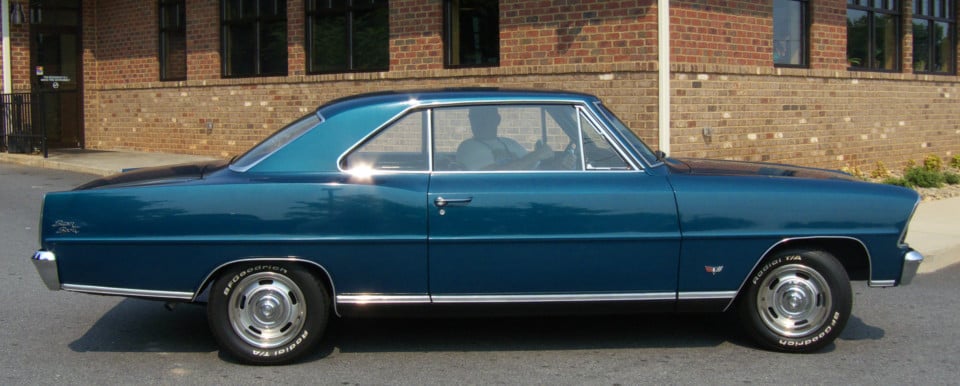
The blue metallic on this Nova Super Sport was perfectly applied and gives the car a crisp, super-clean look.
If you're a beginning painter, then spraying metallics will take a little practice. You want the metallic coats to not go on too light or too heavy. Spray the metallic in medium-coverage coats. The coats need to go on smooth, but still be light enough to distribute the metallics evenly. The biggest problems with spraying metallics are something called tiger striping and mottling.
Tiger striping appears as streaks of lightness or unevenness of color across the surface. To combat this situation, make sure to have a proper pattern overlap of 50- to 75-percent when spraying. Another trick is to change the spray direction. For the first coat, use a horizontal direction, moving the gun from side-to-side. Spray the second coat using an up-and-down direction. I'll even spray in a diagonal direction for the third coat.
Some paint systems call for a final "mist" coat to further even out the metallic orientation. Also, take care to hold the gun at a 90-degree angle to the surface. If the spray gun is tilted or angled, the color will be applied unevenly.
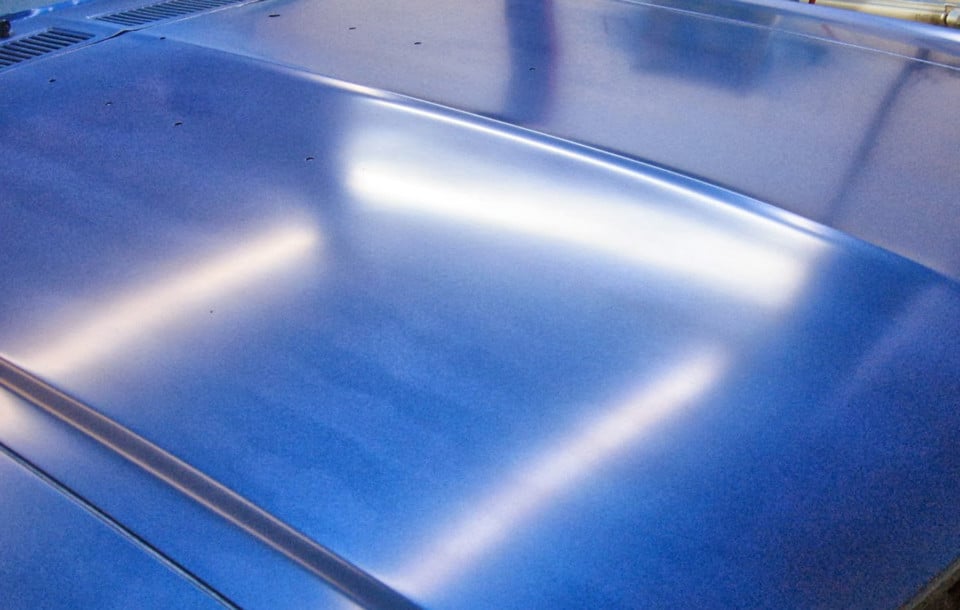
Tiger striping is when streaks of light and dark colors appear on a painted area.
Mottling happens when the basecoat is sprayed too heavy, or the gun is too close to the surface. The paint surface will appear bumpy. By spraying the metallic evenly, you'll get that deep, glossy effect you want when spraying metallics. Holding the spray gun too far away can result in the paint going on too dry and creating a textured, grainy surface. Painting is all about finding a happy medium.
When possible, paint all the panels together and in the orientation they will be installed on the car.
Tri-Color Basecoats: Pearls, Candies, and Flake Colors
Tri-coat paints are a three-step process. First, a basecoat foundation is applied, followed by a transparent candy or pearl, and then a urethane clearcoat. Candy dyes or concentrates, pearl powders, and metal flakes are specialty products added to basecoat paints to obtain a special effect.
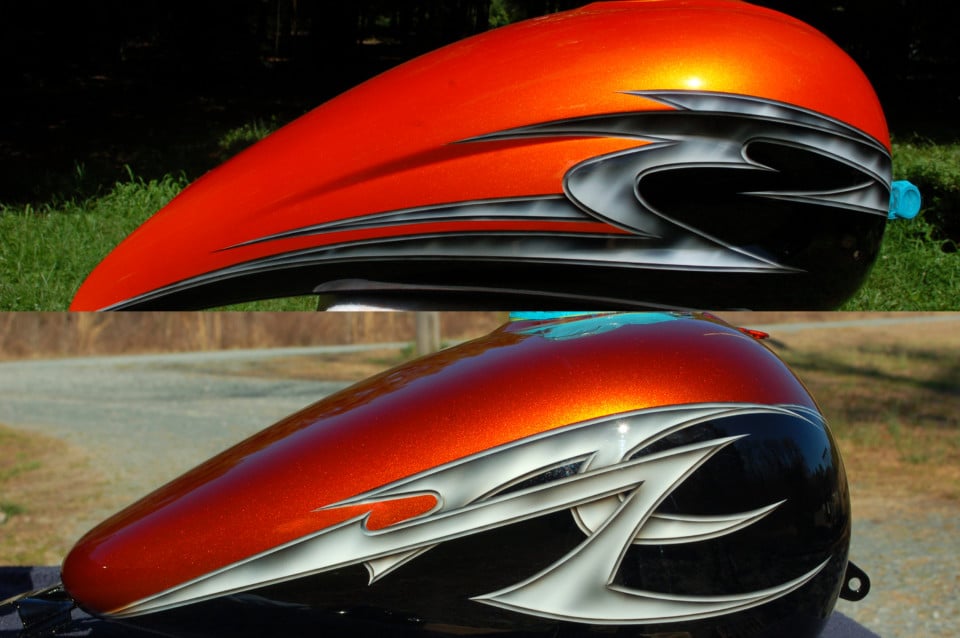
This photo shows the difference between a pearl orange and a candy orange. The pearl orange is on the top tank. It was applied over a white basecoat. The bottom tank has been sprayed with candy orange applied over a silver basecoat. Note how the candy orange goes dark as the surface curves away. How color reacts when viewed from angles is called "The Flop." Candy flops to dark when viewed at an angle, while pearls – if sprayed on a light-color basecoat – tend to stay bright on the flop.
Painting tri-coat colors is much like painting metallic colors. The main thing to remember is the coverage needs to be even. To prepare for painting tri-coats, practice on spare parts, thick white paper, or get a roll of white masking paper, some candy toner, and some basecoat clear and test until you're happy with the result.
A white background is unforgiving and shows every flaw. One of the hardest ways to spray candy is over white. Poor spray patterns show up more prominently with candy than with pearl, that's why it's better to use candy for practice. One of the biggest problems with spraying tri-coats is when the spray pattern is inconsistent. Always paint test pieces to test your spray gun and your paint process before you apply any paint on your project.
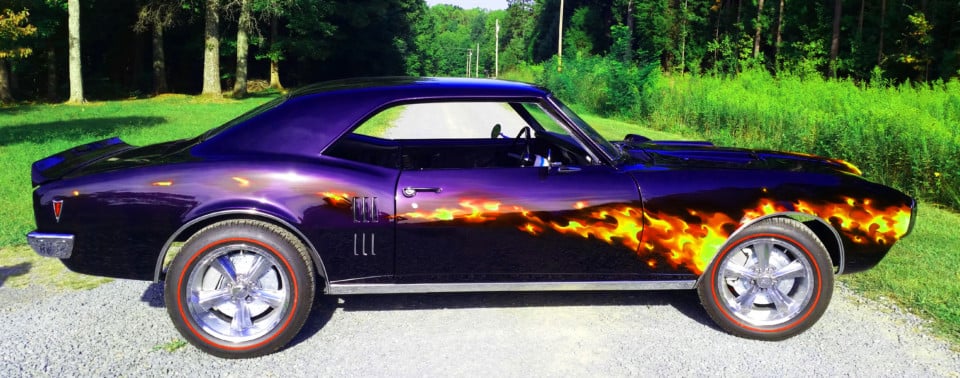
The purple basecoat of this 1967 Firebird was painted with PPG PLRX89, a purple pearl mixed into DBC9700 basecoat black. The result is a purple that is so dark, it sometimes appears black. The brightness of the purple can be adjusted by adding more pearl. If the amount of pearl was doubled, the purple would be brighter and look less like black. If you're mixing the colors yourself, you can fine-tune them by changing the amount of the pearl.
Pearl Paint
Pearl paint is similar to metallic, but the reflective materials are much smaller and finer. Pearl powders come in a number of different particle sizes and various colors. The coloring effects are endless. There are different kinds of pearl paint: pearl powder that is mixed with solid colors and sprayed like a metallic, and pearl powder that is mixed with basecoat clear. The latter is very transparent and is usually applied over a black, white, or colored basecoat.
When pearl gets mixed into a solid color, it turns it into a pearl color. But, it might still retain the opacity (the opposite of transparent – you cannot see through it) of the solid color. Many OEM paint colors have pearl mixed into them, and some will have both metallic and pearl ingredients in them. Spray them as you would a metallic color.
If mixing the materials yourself, you can determine the mix ratio of pearl to basecoat. But, you don't want so much pearl that it thickens the paint or tries to clog the paint gun. This is where test panels come in handy to know how much pearl is needed.
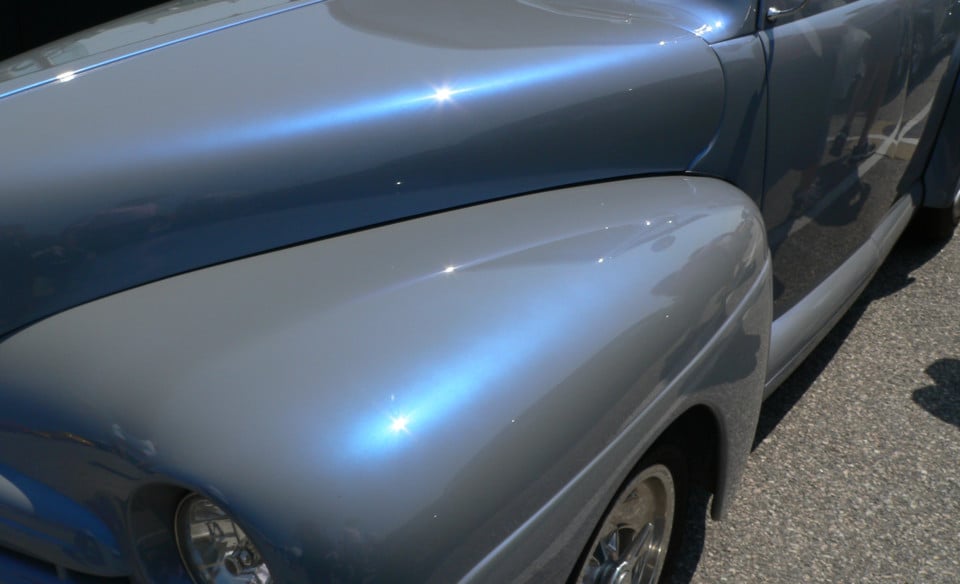
Here's an example of a very transparent pearl being sprayed over a solid basecoat. The gray of the basecoat is still apparent, but the pearl blue gives the paint a glowing, iridescent effect.
If spraying a transparent-pearl basecoat over a solid or metallic basecoat, spray it the same way: not too light, nor too heavy. It usually takes one or two coats of transparent pearl basecoat to achieve the desired effect.
Again, always test your materials on test panels to know how to apply the paint and how many coats will be needed.
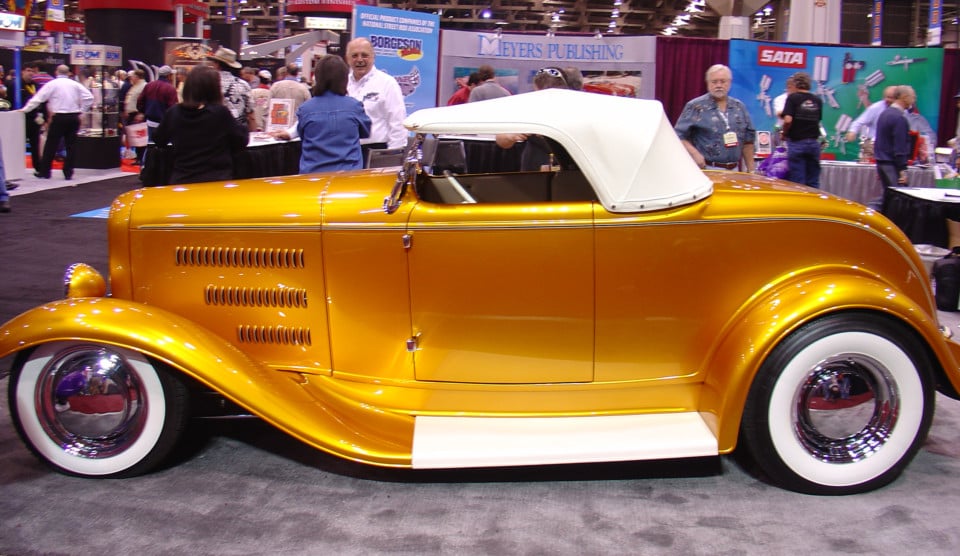
Here is a classic pearl paint job using House of Kolor Goldmine pearl. It's a semi-transparent pearl that's applied over a white base.
Candy Paint
Candy paint is a clear paint with translucent pigments in it. It's sprayed over a metallic or pearl basecoat and allows the sparkle of the basecoat to be seen through the tinted candy layer. How it works is, you buy premixed candy urethanes like Eastwood's Candeez Paint or PPG's Vibrance Line of Radiance II candy urethanes. Or, you can mix the candy dye or concentrate into basecoat clear or urethane clearcoat. For the novice painter, it's easier to buy a premixed candy urethane.
Candy colors are more challenging to paint than pearl colors because flaws and spraying or coverage inconsistencies tend to show up more than with pearl. The thicker the candy paint, the darker the color will be. If the coats are inconsistent, the color will appear streaked or spotted. If the spray gun spits out a blob of color, it will result in a dark spot on the surface that cannot be blended. Also, any bits of dust that land in the paint may appear as dark spots. If your painting area is not super clean, candy paint might not be the best choice for your project.
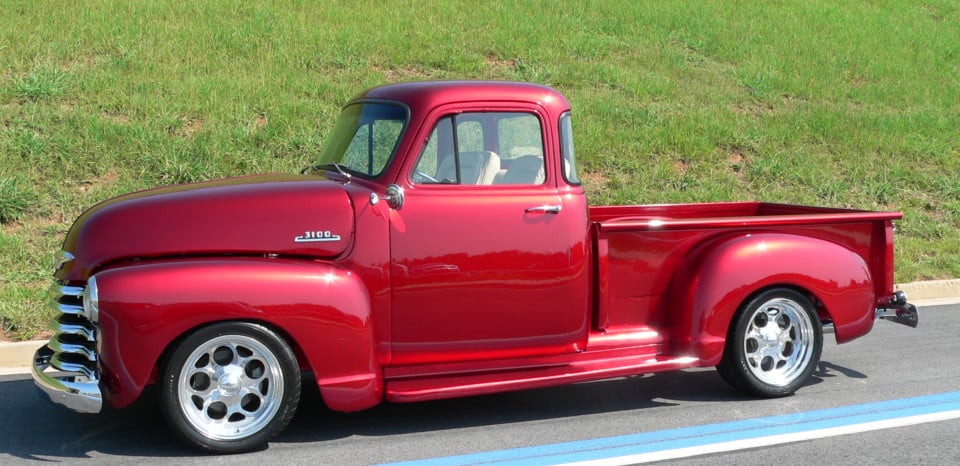
Here is a classic Candy Apple Red paintjob. The red candy was evenly applied.
For a successful candy paintjob, plan on spending some time training yourself to spray the color. Get some white poster board and practice spraying smooth, even coats. Once you're happy with the results, try some tests using your metallic base color. Before you paint a car with candy paint, make sure you have a good idea of the spray technique, how fast you need to be moving the gun, and the amount of overlap. Don't forget to change your painting direction.
But what can make or break a candy paintjob? The way the gun is spraying! That spray pattern has to be even and unflawed, or else it will be impossible to get an even coat of candy on the surface.
Picking The Right Basecoat For Your Candy
The choices are endless when it comes to the basecoat under your candy paint. Very fine metallics or pearl basecoats can give a sleek, elegant effect. Courser, brighter metallics give a blingy, bright-sparkle effect. Spend some time with a candy-color chart and see the different effects various bases have. Or, you can play around with a few and come up with your own custom basecoat to use under the candy.
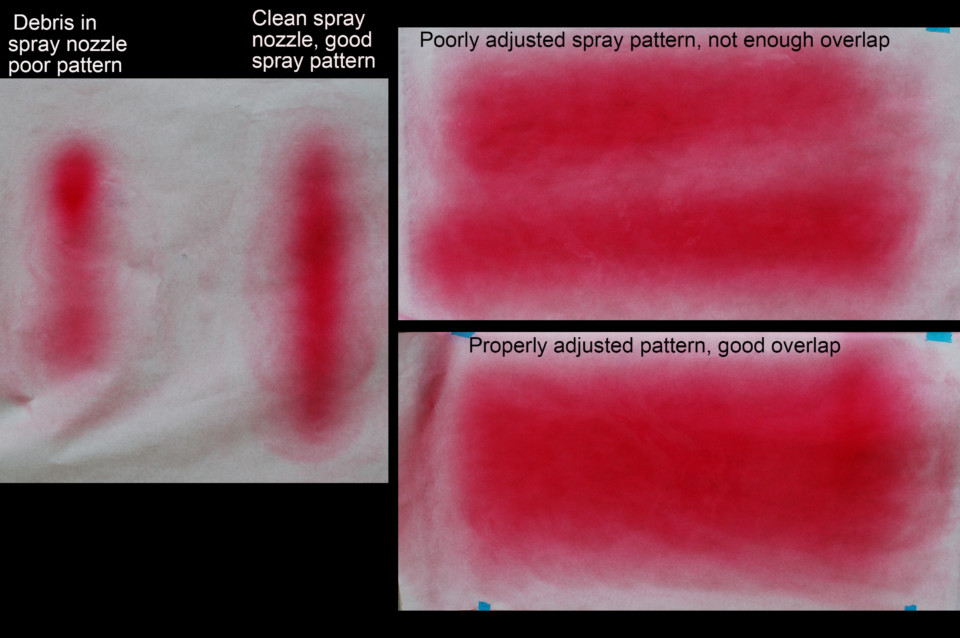
Having a proper spray pattern and overlap makes all the difference in the success of a candy paintjob. By testing and practicing on white masking paper, you can refine your spray gun and your skills.
The metallic or pearl basecoat is just as important as the candy color. The amount of sparkle or bling the base delivers is up to you. A fine, medium, or course metallic may be used. Aggressive pearl powders or flakes may be added to give the base even more bling. Any color metallic or pearl may be used under candy. Gold metallics tend to give the candy a warmer tone than silver. Use a purple metallic base under a candy red and get a rich deep burgundy. Put a green metallic under a Cherry Candy and get a sparkly purple-red with a depth that seems endless.
Play around and experiment with candy and pearl colors. Liven up a candy color by adding a little pearl powder to it. But know that adding a pearl to candy will mute the effect of the candy, so go very lightly with the pearl if you try this.
Flake Paint
Most paint companies have their own line of flake paint. Most of the time, it comes as a dry substrate in a jar and needs to be mixed with paint. The flakes are made from a very thin polyester. Modern flake comes in many colors, is thin, and lays down flat, requiring less clear to level out the surface. Flake paint ranges in size from ultra-micro flake .002-inch to bass-boat-sized big flake at .62-inch. The most popular size of flake is .15-inch. Spraying flake requires a very large nozzle size in the spray gun (1.7 or larger). Flakes should be mixed with a ratio of about two tablespoons of flake per mixed and reduced quart of clear basecoat.
The two biggest problems with painting flake colors are the rough surface of the freshly applied flake paint and the mess that results from the application. The flakes are best sprayed over a similar-colored metallic base, as it is difficult to get total coverage with metalflake paint.
Try to find a very coarse metallic base that is almost the same color as your flake, but just a little darker. Spray the metallic coats then apply several medium-to-wet coats of the flake. Again, testing your paint can make all the difference in your success, as you can know what to expect and can adjust your paint and your technique as needed.
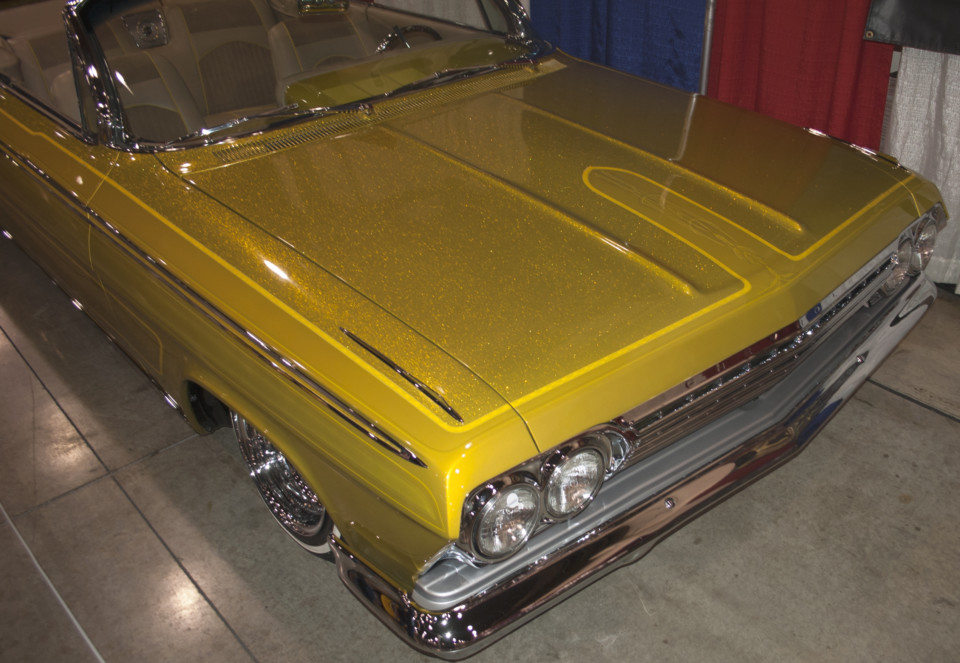
Flake paint is usually painted as panels to compliment the base color of the car.
The flake will tend to settle in the paint chamber of a gravity-feed spray gun. So, before spraying each coat, hold a wadded-up cloth over the spray nozzle and slightly pull the trigger of the spray gun. This causes air to flow backward through the spray gun and clear away any stuck material. But don't pull the trigger back all the way, just slightly.
Make sure to leave plenty of time for the basecoat/flake layers to gas out before spraying urethane clearcoat. Apply three to four coats of urethane clear over the flake layers and allow to thoroughly cure for a few days. Then wet-sand and apply your finish-urethane clear. Use care when sanding the clearcoat over the flakes. You want to get the surface flat, but try not to sand and cut into the flakes. A second round of clearcoat is sometimes needed to flatten out the surface.
Flake is heavy stuff, and unless you're using a downdraft booth (a booth with the outtake filters right in the floor beneath the car), it's a pain to clean up. The flakes are heavier than metallics or pearl colors, and they tend to land everywhere. The floor will be covered with them.
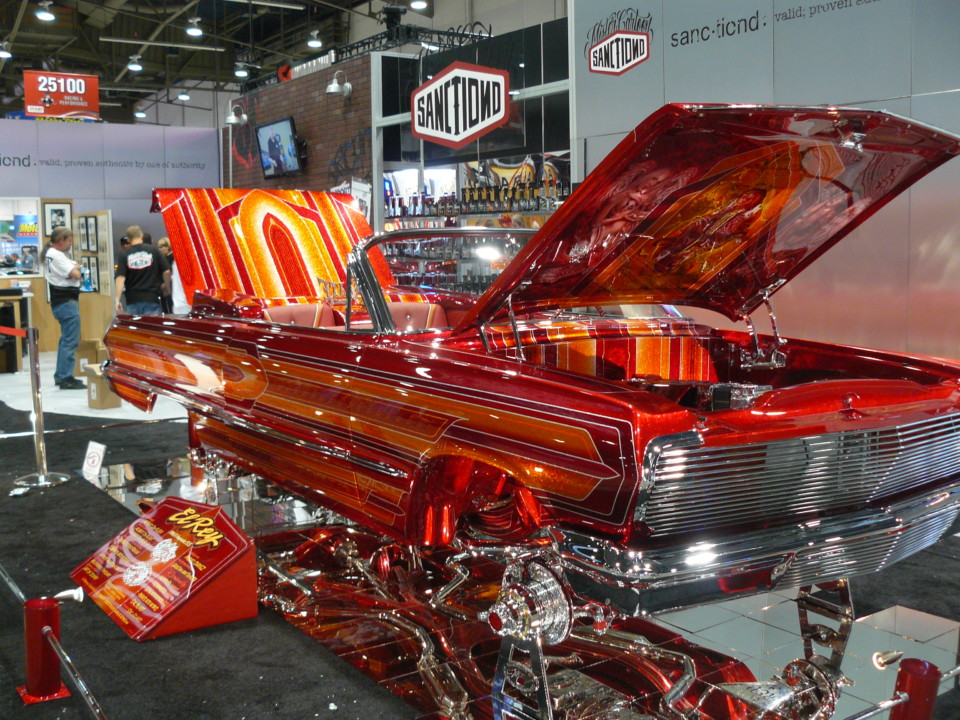
Lowrider cars are known for their outrageous flake paint jobs.
One trick to help keep the flakes under control is to cover the floor with masking paper to catch any loose flakes. Simply roll up the paper when you're done. If you're attempting to spray flake in a garage, go out and get some disposable drop cloths, and drape them over everything. In fact, if you choose to spray any paint in your garage, cover everything with drop cloths and hang plastic to cover the walls.
How Much Paint Do You Need?
For solid or metallic colors, a gallon of basecoat will typically be enough for the average-sized car. When spraying a tri-coat, plan on a gallon of metallic base and a gallon of candy. If you're painting the door jams, trunk, and engine compartment, you will need to order more paint. It's always better to have too much rather than run out at the end of the job. This can create a serious problem, as recoat windows are very strict if you're using urethane paints.
That's all about basecoats. Next time, we'll cover urethane clearcoats and how to get the best results when spraying what can be the most expensive item on your paint list. Good luck with all your painting projects!
Source: https://www.chevyhardcore.com/tech-stories/paint-body/painting-101-choosing-the-basecoat-and-spraying-color/
0 Response to "Dark Blue Non Metallic Base Clear Coat Auto"
Post a Comment